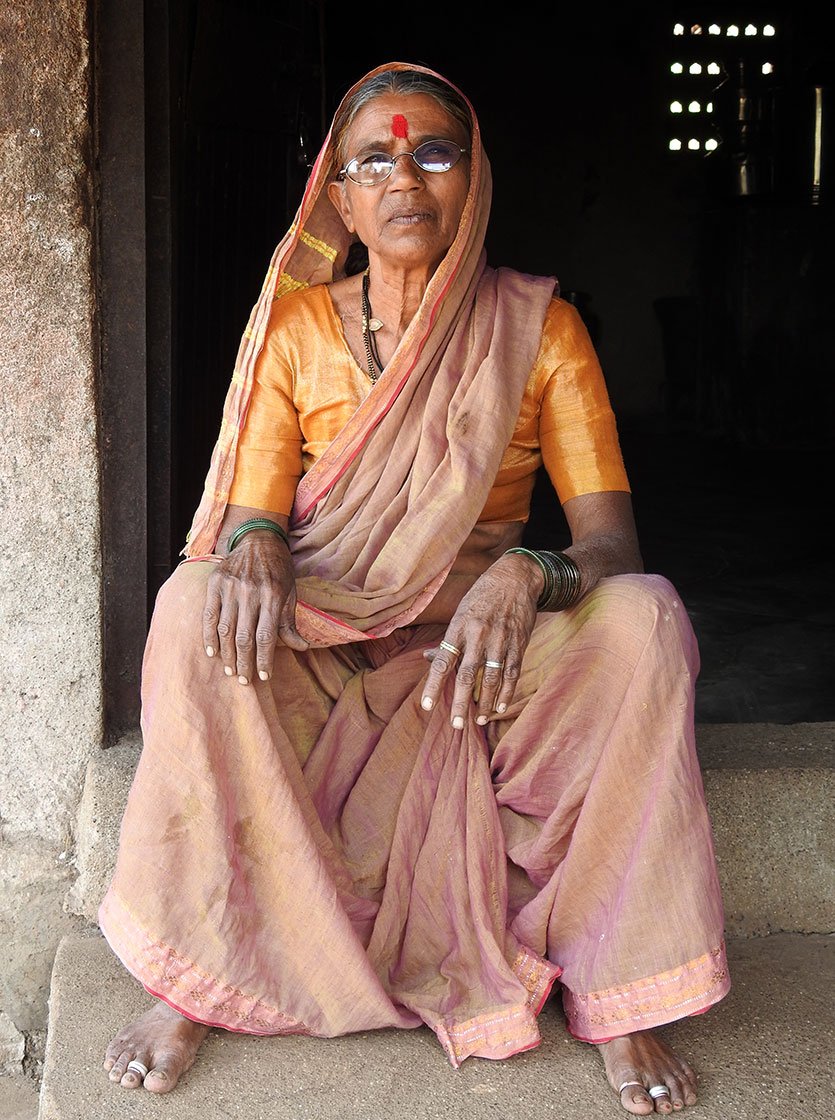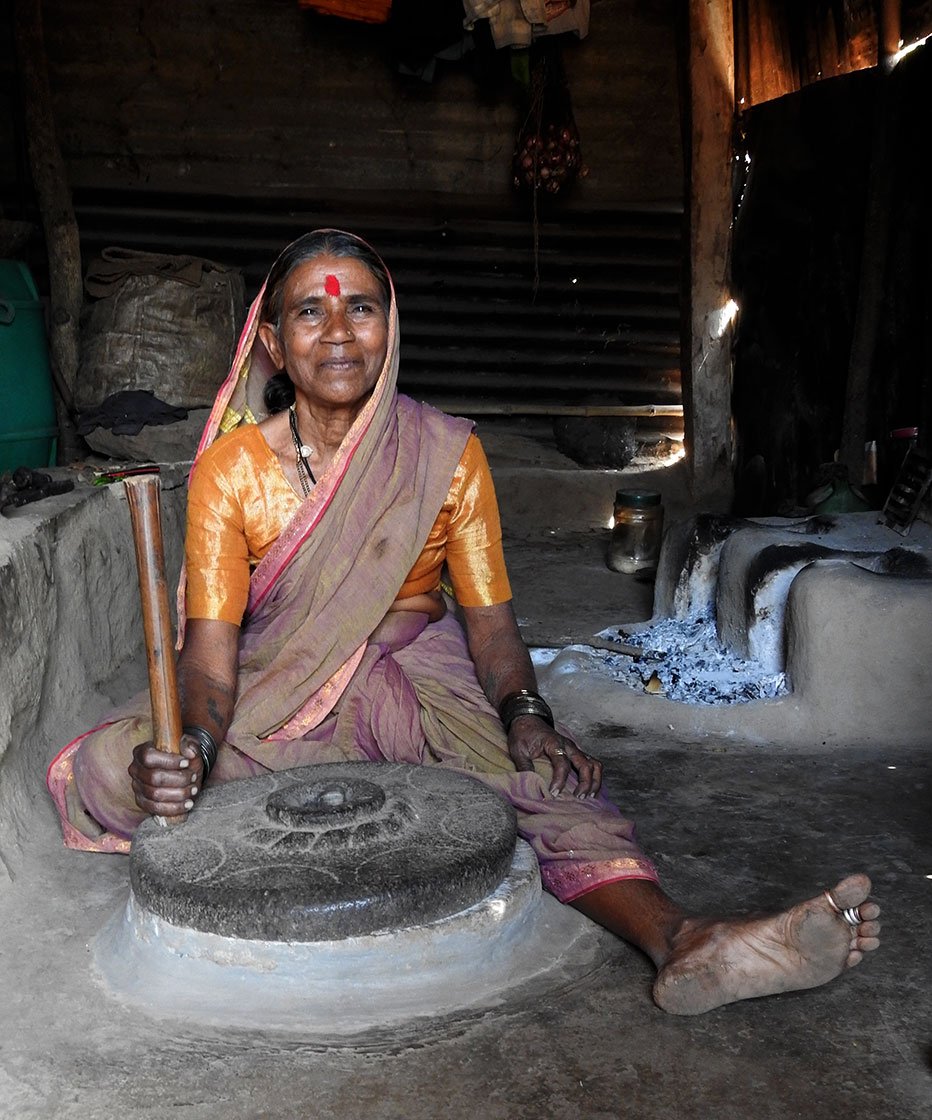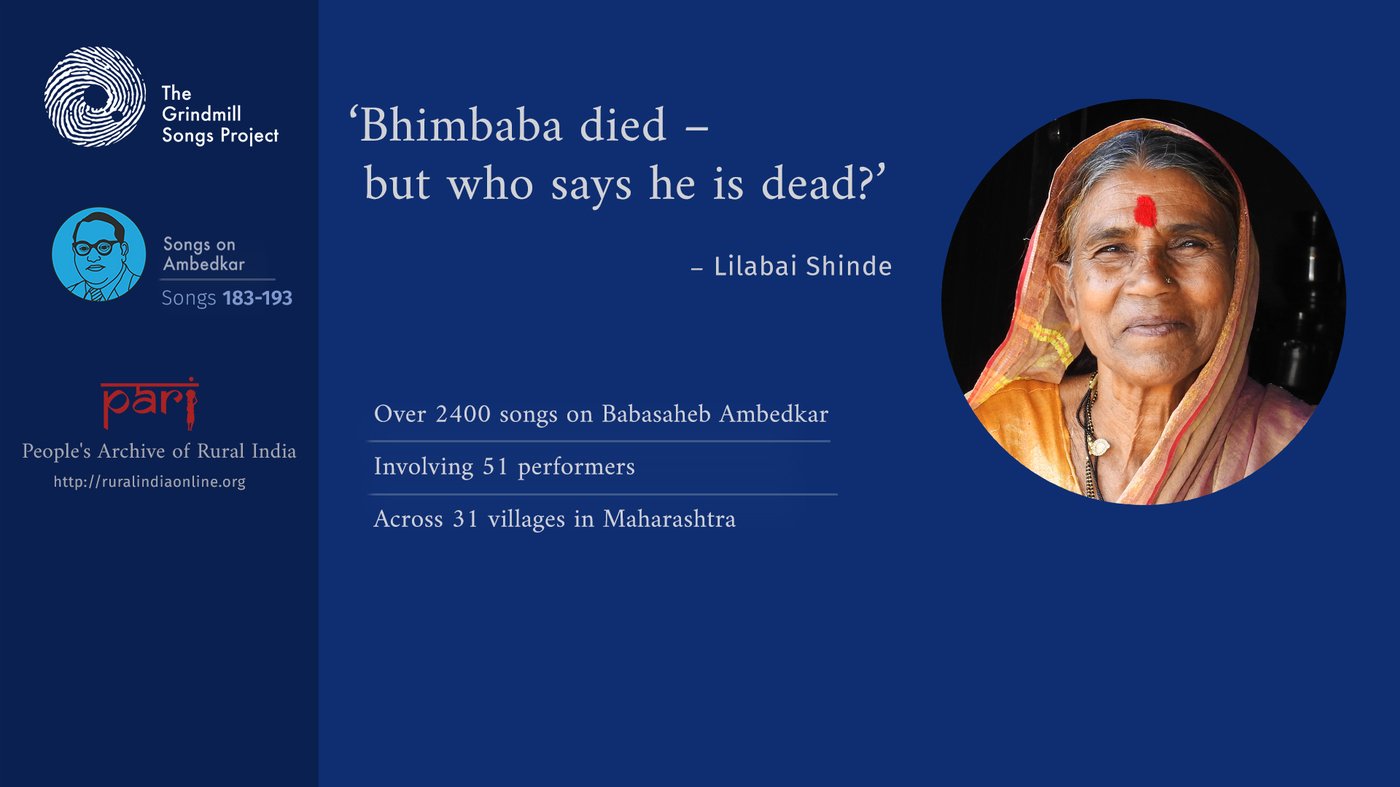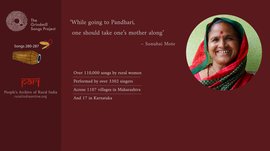For Babasaheb Ambedkar’s death anniversary on December 6, the Grindmill Songs Project presents
ovi
by Lilabai Shinde of Lawarde village, who sings of Dr. Ambedkar with affection, reverence and gratitude
"My house is being rebuilt, so we are living in my mother’s home," says Lilabai Shinde of Lawarde village in Mulshi taluka , Pune district, when we visit her in April 2017. She is the only daughter of Jai Sakhale, a singer from the grindmill songs database, who had lived next door to her. After showing us her mother’s framed photograph, Lilabai wraps it neatly in newspaper and puts it in a tall tin box used to store grain. Seeing our puzzled faces, she explains: "There are no nails on the walls of this house."

Lilabai and her mother both contributed couplets to the grindmill songs database
On our visits to meet the singers whose work is in the database, we realise that many are related by birth or marriage. Some are mothers and daughters, others are sisters or sisters-in-law, and still others are mothers-in-law and daughters-in-law. Lilabai’s mother, who passed away in 2012, left behind ovi that were featured in The farmer and the rain song in May 2017.
The original grindmill songs team had handwritten seven ovi by Lilabai, but they had not been recorded on audiotapes. So during our visit, we requested that she sing for our camera. Though reluctant at first, she eventually agreed. She took us to the grindmill in the roofed courtyard outside her home and sat down before it. She held the bamboo stick that turns the mill’s wheel and sang 11 ovi in praise of Babasaheb Ambedkar.
Dr. Bhimrao Ramji Ambedkar was born on April 14, 1891, in Mhow, a cantonment town in what were then the Central Provinces (today’s Madhya Pradesh). A social reformer, political leader, jurist and the architect of India’s Constitution, he died on December 6, 1956 in Delhi at the age of 65.
Babasaheb Ambedkar fought lifelong for the rights of the oppressed. The essay The Annihilation of Caste (1936), widely considered his magnum opus, was an integral part of his crusade to bring justice to the underprivileged castes and to affirm the values of liberty, equality and fraternity. ‘Educate, agitate, organise!’ was his message to his followers.
Babasaheb Ambedkar brought much-needed hope to Dalits by showing them the path of education and embracing Buddhism. It was a way out of the oppression of caste-based Hindu society, which branded them ‘outcastes’ and ‘impure’.
The grindmill songs of Lilabai Shinde
In these
ovi
, Dr. Ambedkar is affectionately called Bhim, Bhimbaba, Bhimraya or Babasaheb. They express pride in his achievements, and the desire to be treated with respect
These ovi express the reverence and gratitude that many Dalits, especially women, have for Dr. Ambedkar. But they do so in a very personal way – he is affectionately called Bhim, Bhimbaba, Bhimraya or Babasaheb. They also express pride in Dr. Ambedkar’s achievements, and the desire to be treated with respect and to be seen as equals.
“Bhim is my gurubhau [teacher and brother],” sings Lilabai of Dr. Ambedkar. For her, he is a guide, a confidant, a brother. (People of different sexes or castes nurture such relationships without the fear of societal opposition. If the man is a gurubhau , the woman is a gurubahin , that is, a teacher and sister.) Lilabai sings that she feels so blessed, her pestle may as well be made of gold. Taking Bhim’s name, she says, brings sweetness to her mouth; she feels “purified” (and no longer "untouchable") just thinking of him.
The temple of Buddha has a golden door, says Lilabai in the fourth couplet, and that her son is very devoted to the Buddha. The singer’s mother, we learn, hurriedly wore a white sari to take diksha from Babasaheb, to embrace Buddhism.

Lilabai at the grindmill just outside her home
In the fifth couplet, the singer asks: “Who calls us outsiders?” She means: Who calls us "outcastes"? Bhim, she reminds us, has made all Brahmins his brothers-in-law. (This is a reference to the fact that Dr. Ambedkar’s second wife Savita was a Brahmin.)
In the sixth
ovi
, Lilabai, who wants to buy jasmines to decorate Bhim’s turban, asks a woman gardener, “What do you have in your basket?” In the seventh, she says that on the train that’s arriving (a symbol of progress) are stalks of
tur
(a legume), which symbolise honour and prosperity, while the “Marathi people” dispose animal carcasses. In this
ovi
, she vents the anger many Dalits have towards the upper castes – generations were compelled to clean up and remove animal carcasses and many are forced to do so even today. The train with stalks of
tur
signals progress and a future of respect for Dalits while the “Marathi people” refers to the upper castes who have forced Dalits to do menial, degrading work.
In the last three ovi , the singer laments the loss of Dr. Ambedkar. He may be no more, she says, but he is the king of Indrasabha, the council of gods in heaven governed by Lord Indra in Hindu mythology. She offers rice to God, feeling thankful that the precious Bhimrao of the Dalits, their gold, is now in heaven.
The final
ovi
tells us that after his death, Bhimbaba’s body was taken away in a car and as the vehicle moved, people walked behind it. This also symbolises the path chosen by many Dalit followers of Dr. Ambedkar. Like him, they left the Hindu fold and embraced Buddhism. And following in his footsteps, chose to educate themselves so they may live free of oppression.
भीम भीम म्हणू भीम माझा गुरुभाऊ
सोन्याच्या सळयी देते तांदळाला घावू
भीम भीम म्हणू भीम साखरचा खडा
ध्यान येता मनी गोड झाल्यात दातदाढा
बुद्धाच्या मंदिराला सोन्याची कवाड
माझ्याही बाळाला लई बुद्धाची आवड
पांढऱ्या साडीला नेसते गं घाई घाई
बाबा साहेबाची दिक्षा घेती माझी आई
आमच्या लोकाला कोणं म्हणे वाले वाले
आमच्या भीमानी बाह्मण गं केलं साले
माळीण बाई तुझ्या टोपलीत काई
भीमाच्या तुर्याला इकत घेते जाई
आली आगीणगाडी गाडीला तुरकाठी
माझ्या भीमाच्या राज्यात ढोर वढाती मराठी
मेले भीम बाबा कोणं म्हणे मेले मेले
स्वार्ग्यात गेले इंद्रसभेचे राजे झाले
स्वर्गीच्या देवा तुला तांदळाचं वाण
मेले भीम बाबा स्वर्गी आहे आमचं सोनं
मेले भीम बाबा यांचं गाडीत मैत
पुढे चालती गाडी मागं चाललं रहित
bhīma bhīma mhaṇū bhīma mājhā gurubhā'ū
sōn'yācyā saḷayī dētē tāndaḷālā ghāvū
bhīma bhīma mhaṇū bhīma sākharacā khaḍā
dhyāna yētā manī gōḍa jhālyāta dātadāḍhā
bud'dhācyā mandirālā sōn'yācī kavāḍa
mājhyāhī bāḷālā la'ī bud'dhācī āvaḍa
pāṇḍhaṟyā sāḍīlā nēsatē gaṁ ghā'ī ghā'ī
bābā sāhēbācī dikṣā ghētī mājhī ā'ī
āmacyā lōkālā kōṇaṁ mhaṇē vālē vālē
āmacyā bhīmānī bāhmaṇa gaṁ kēlaṁ sālē
māḷīṇa bā'ī tujhyā ṭōpalīta kā'ī
bhīmācyā turyālā ikata ghētē jā'ī
ālī āgīṇagāḍī gāḍīlā turakāṭhī
mājhyā bhīmācyā rājyāta ḍhōra vaḍhātī marāṭhī
mēlē bhīma bābā kōṇaṁ mhaṇē mēlē mēlē
svārgyāta gēlē indrasabhēcē rājē jhālē
svargīcyā dēvā tulā tāndaḷācaṁ vāṇa
mēlē bhīma bābā svargī āhē āmacaṁ sōnaṁ
bhīmarāyāca āla gāḍīta maita
mhōra cālala maita māga cālala rahita
Bhim, Bhim, I say, Bhim is my
gurubhau
[teacher-brother]
I pound the rice with a pestle of gold
Bhim, Bhim, I say, Bhim is like a chunk of sugar
I think of him and my teeth are sweetened
Bhim, Bhim, I say, Bhim is like a packet of sugar
By taking Bhim’s name my body is purified
The Buddha’s temple has a gold door
My son is very devoted to the Buddha
She wears the white saree hurriedly –
My mother takes
diksha
from Babasaheb
Who says to our people 'Outsiders! Outsiders!'
My Bhim has made all Brahmins his brothers-in-law
O gardener woman, what [flowers] do you have in your basket?
I want to buy jasmines to decorate Bhim’s turban
Here comes the train, which has stalks of
tur
In my Bhim’s kingdom, the Marathi people dispose the carcasses
Bhimbaba died – but who says he is dead?
He has gone to heaven and become the king of Lord Indra’s council
God of heaven, an offering of rice to you
Bhimbaba is dead, our gold is in the heaven
Bhimbaba is dead, his body is in the car
The car goes ahead, people follow behind

Performer/Singer : Lilabai Shinde
Village : Lawarde
Taluka : Mulshi
District: Pune
Caste: Nav Bauddha (Neo-Buddhist)
Age: 60
Children: Three sons and a daughter
Occupation: Rice farmer
These songs were recorded on April 30, 2017.
Poster: Sinchita Maji




